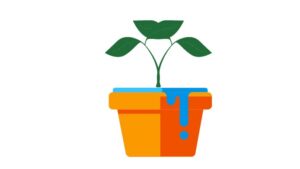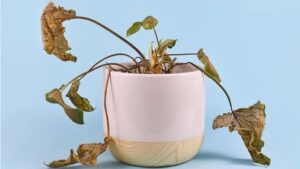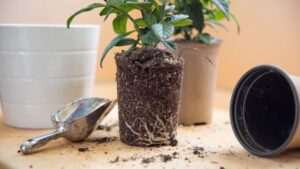Have you ever walked into your garden to find your beloved flowers wilting and drooping? Don’t fret! Okayreview got you covered with some helpful insights and practical solutions.
A drooping flower or leaves plant wilting can leave us feeling disheartened but fear not because we’re here to illuminate the possible causes behind this phenomenon.
By understanding why your flower may be wilting, you can take proactive steps to revive its beauty and vitality.
So, let’s embark on a journey to uncover the mysteries behind flowers wilting!
Table of Contents
What Are the Main Reasons for Flower Wilting?
Nobody likes to see their houseplant looking wilted and sad. There are several reasons why this might be happening, most of which are easy to fix.
So if you’ve got a droopy indoor plant, let’s work out what’s wrong with it and how to perk it back up.
1. Overwatering
 Overwatering occurs when a plant receives too much water, resulting in wilted and yellow leaves.
Overwatering occurs when a plant receives too much water, resulting in wilted and yellow leaves.
Waterlogging causes the leaves to become limp and floppy.
Suffocated roots are unable to absorb water effectively. Even though the soil seems humid, flower wilting is caused by a water shortage within the plant.
Flower wilting may droop or shut up. You can prevent the drooping by repotting the plant in looser soil and a bigger container.
Solution>>
To begin addressing overwatering, check the soil moisture. Allow the plant to dry out if it is saturated.
Water when the top two inches of soil are dry in the future. Flower wilting may be avoided by repotting in looser soil and a bigger container.
2. Underwatering
 Underwatering can produce leaf dryness without causing yellowing. Browning, limpness, and crispy edges are signs of insufficient water.
Underwatering can produce leaf dryness without causing yellowing. Browning, limpness, and crispy edges are signs of insufficient water.
According to research published in the Journal of Tropical Ecology, underwatering can cause houseplants to droop.
Solution>>
To address underwatering, feel the soil to determine its moisture level. Increase the frequency of watering if it is scorched.
However, stick to the same rule: only water when the top two inches of soil are dry.
3. Lack of Light
 Insufficient light can induce flower wilting because the plant cannot absorb enough light to sustain itself.
Insufficient light can induce flower wilting because the plant cannot absorb enough light to sustain itself.
If the plant is put in an area with inadequate light, it may droop due to a lack of energy.
To prevent straining the plant, gradually relocate it to a brighter spot.
Solution>>
To compensate for a shortage of light, gently place the plant closer to a window.
Avoid overexposure to direct sunlight since it might stress the plant. Gradual adjustments will aid the plant’s growth.
4. Aging Growth
 Flower wilting is a good thing for plants. A few withered leaves towards the bottom of a plant might signal that it has ended its lifetime.
Flower wilting is a good thing for plants. A few withered leaves towards the bottom of a plant might signal that it has ended its lifetime.
It is a natural process in which older leaves perish.
It is a typical component of the plant’s aging and development, particularly with the oldest leaves near the bottom outside border.
Solution>>
Trim wilting leaves or flowers to manage aging growth. It transfers the plant’s energy to new growth, resulting in a healthy rejuvenation process.
There’s no need to be concerned because this remedy promotes vitality and renewal.
5. It’s Outgrown Its Pot
 Your plant may have outgrown its present container if it has been in the same pot for a few years.
Your plant may have outgrown its present container if it has been in the same pot for a few years.
A tiny pot restricts nutrition absorption, causing flower wilting.
Rootbound plants require a bigger container to receive appropriate nutrients and water for development. Repotting your plant into a larger container will help it recover.
Solution>>
Consider repotting a plant that has outgrown its container during the active development season between March and September.
See our thorough repotting guide for extensive advice on effectively transplanting your plant.
6. Temperature
 Temperature is critical to plant health. Plants may wilt when exposed to high temperatures owing to fast water loss.
Temperature is critical to plant health. Plants may wilt when exposed to high temperatures owing to fast water loss.
On the other hand, extreme cold can stress plants and cause withering.
Maintaining ideal temperature conditions supports appropriate plant hydration and lowers stress, contributing to healthy development.
Solution>>
Position your plants in a warm and constant setting to manage temperature difficulties.
If a space feels cozy, it’s also comfortable for your plants. Allow a week for improvement before seeking guidance from plant specialists.
How Can I Prevent Houseplants From Drooping?
To prevent houseplants from drooping, here are two useful tips:
1. Improve Soil’s Water Retention
Line containers with plastic bags to create a barrier that efficiently maintains moisture inside the soil and increases water retention.
Remember to poke holes in the bags to allow appropriate drainage. Alternatively, introducing organic matter into the soil, such as compost or peat moss, can improve water retention.
Another alternative is to use water-retaining gel granules, which absorb and release water as needed, ensuring your plants have a continuous moisture source.
2. Avoid Overwatering
Overwatering is a major cause of houseplant drooping. It is critical to water your plants when they want it but avoid overwatering. Using a moisture meter is one approach to guarantee correct irrigation.
This useful instrument determines the moisture level in the soil, allowing you to water your plants just when necessary and prevent watering while the soil is still damp.
Using a moisture meter, you can avoid overwatering and give the proper quantity of water for your houseplants’ requirements.
Implementing these two tips can greatly help in preventing drooping in your houseplants. Improving soil’s water retention and monitoring watering practices are essential for maintaining healthy and thriving plants.
Final Thoughts
Understanding the numerous causes of their drooping look allows you to restore their lively appeal proactively.
Remember that prevention is essential! So, let’s roll up our sleeves and give those wilting flowers the care and attention they deserve!
Happy gardening!!

